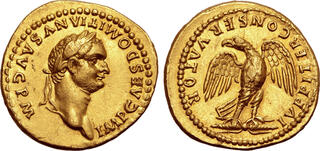| Roma Numismatics Ltd > Auction XXX | Auction date: 21 March 2024 |
| Lot number: 433 Price realized: 24,000 GBP (Approx. 30,403 USD / 27,992 EUR) Note: Prices do not include buyer's fees. | Show similar lots on CoinArchives Find similar lots in upcoming auctions on |
| Lot description: Domitian AV Aureus. Rome, AD 82-83. IMP CAES DOMITIANVS AVG P M, laureate head to right / IVPPITER CONSERVATOR, eagle, with spread wings and head to left, standing facing perched on thunderbolt. RIC II.1 143b; C. 319; BMCRE 51; BN 49 var. (wings raised); Calicó 895. 7.74g, 21mm, 6h. Good Extremely Fine. Very Rare. Ex G.T. Collection of the Twelve Caesars, Roma Numismatics Ltd., Auction XX, 30 October 2020, lot 501; Ex Numismatica Ars Classica AG, Auction 100, 29 May 2017, lot 462 (hammer: CHF 32,000). The aquila (eagle) has long been regarded as one of the most ancient and enduring emblems of the Roman people. Its importance to the Romans derives from its association with Jupiter, supreme deity of the Roman pantheon, revered as the patron of the Roman state since the earliest days of the kings. Stemming ultimately from the Greek tradition of the 'aetos dios' being the personal messenger and companion of Zeus, its mythological history is uncertain, and the surviving sources are very late; according to Antoninus Liberalis (Metamorphoses VI), c. AD 100-300, it was once a mortal king name Periphas, renowned for his just and noble rule, transformed by Zeus and made king of the birds. Fulgentius (Mythologiarum Libri III), c. AD 475-525 relates the eagle as being a creation of the primordial goddess Gaia, appearing before Zeus at the start of the Titanomachy, the great war between the Olympian gods and their predecessors the Titans, which Zeus took to be a favourable omen of victory leading him to adopt the eagle as his own attribute: "for so happy an omen, especially since victory did ensue, he made a golden eagle for his war standards and consecrated it to the might of his protection, whereby also among the Romans, standards of this kind are carried." Frequently employed as a representative motif with protective connotations invoking the divine assistance of Jupiter (hence the thunderbolt it often clutches), the eagle itself was associated with strength, courage and far-sightedness, on account of which qualities it was readily adopted by the Roman military as a legionary ensign along with the wolf, bull, horse and boar (Pliny the Elder, Naturalis Historia X.16). From the second consulship of Gaius Marius in 104 BC, the Aquila became the sole symbol of the Roman legions. On the Roman coinage, the eagle was utilized on some of the earliest issues, appearing on aes signatum (BMC 2, Crawford 4.1a) in the early-mid third century BC, and on the gold coinage issued during the Second Punic War c. 211-207, and subsequently employed sporadically throughout the time of the Republic. Its usage on Imperial coinage after the reign of Augustus is surprisingly limited, but the type was revived by the Flavians for issues of gold and silver, after which time the eagle appears almost invariably either on 'consecration' issues denoting the elevation of an emperor or empress to a status of divinity (as when Zeus sent his eagle to fetch the handsome youth Ganymede to heaven to become the cup-bearer of the gods), or as an adjunct symbol. It would not be until after the fall of the Western Empire that the eagle would once again be featured as the principal type of the coinage of Rome, c. AD 493-534; this municipal coinage would also be the last issued by the ancient Romans in their own name. As such it may be argued that there is a melancholic circularity to the Roman coinage as there is also found in the names of her rulers: as Romulus and Augustus were the first king and first emperor, and Romulus Augustus the last emperor, so too was the eagle boldly imprinted on both the earliest and last coins of Rome. Estimate: 20000 GBP |  |


